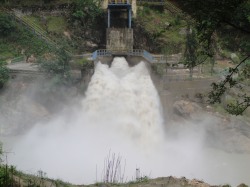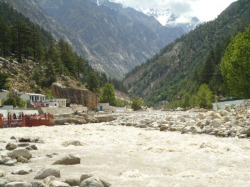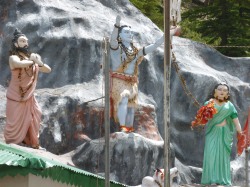Chardham Yatra
History of Gangotri
Gangotri, (Ganga' + 'Uttari' which means descended) the picturesque pilgrimage in the hinterlands of the Himalayas is the most sacred spot .
Gangotri is significant pilgrim and tourist place. Gangotri is situated at 3,048 m above sea level. The Gangotri glacier is the unique source of river Ganga.
The pictorial beauty of Gangotri’s history calls it back to times, when Goddess Ganga (daughter of heaven) descended herself in the form of a river to pardon the sins of king Bhagirath’s predecessors followed by their penance of 5500 years. In order to control the flow of holy river Ganga and minimize its impact, Lord Shiva took her in his locks. Along with being called Ganga, she was also known as Bhagirathi as it came down for the purpose of Bhagirath’s penance.
As per the legends speaks, King Sagar, after assassinating the demons on earth, performed an Aswamedh Yagna to declare his supremacy. The King's 60,000 sons born of Queen Sumati and one son Asamanjas of Queen Kesani were to accompany the horse. At this, Lord Indra feared the defeat of his supremacy and stole the horse. Then, he tied it to the ashram of ancient “rishi” Kapil, who was had been into deep meditation. While searching for the horse, those 60,000 sons stormed the ashram of Kapil. Just before the attack on him, the sage Kapil opened his eyes and abridged all the 60,000 sons of King Sagar except Asamanjas to ashes.
King Sagar's grandson Anshuman was triumphant in recovering the horse from Kapil and was told that those 60,000 burnt will achieve heavenly adobe, if Ganga is brought down from heaven and their ashes will be sleaned by its water. Anshuman failed in bringingGanga to earth and so did his son Dilip also; but his grandson Bhagirath succeeded in bringing Goddess Ganga to earth from its heavenly abode.
The intense meditation made Ganga to descend from heaven. After Lord Shiva collected her in his hairs, he released it into seven streams on getting happy with the King Bhagirath. And finally, the ashes of those 60,000 sons were touched by riverGanga and they got their peaceful abode in heaven.
Famous Attractions-Gangotri
Gangotri is the place of Goddess Ganga and have an extreme touch of serenity in the environment. The famous attractions in this region are:
Gaumukh Glacier
The Gangotri Glacier is one of the sacred glaciers of Uttaranchal having special importance in the history of India and Hinduism. It is quite eminent for being the birth source of the River Ganga. A tour to the Gangotri Glacier is known as an important form of pilgrimage, not just for Hindus, also for all religions. Considered as a trekker’s paradise, the Gangotri Glacier is an important tourist attraction in Uttaranchal.
Nestled in the Garhwal region of Himalayas, Uttarkashi, the Gangotri Glacier is a group of a number of glaciers that are fed into the main glacier and end up forming a huge mass of ice. These glaciers include), Kirti Stambh (6285), Hrigupanth (6772m), Sumeru Parvat (6380) respectively and Chaturangi Bamak, Ratavana Bamak and Swachand Bamak.
Gangotri Temple
The Gangotri temple is the holy abode of Goddess Ganga, from where it comes as a refreshing stream of sacredness. The temple of Gangotri stays open from May 1st week to the 3rd week of October. After closing of the temple, goddess Ganga is taken to a place situated at a lower height than the Gangotri as these areas witness heavy snow fall during winters. From this temple, visitors can take away the holy water of Ganga in small cans.
This temple is built near a sacred stone, called Bhagiratha Shila. Immediately after the aarti to the deities in the temple, an aarti is carried out to the holyGangesRiver.
Submerged Shivling:
There is a natural rock Shivling, which is submerged in the river and has an amazing sight strengthening the power of celestial. According to the folklore, Lord Shiva sat here to receive the Ganga in his entwined locks. This shivling is seen in the early winters, when the water level goes down. The striking pilgrimage in the hinterlands of the Himalayas is the most sacred spot where Ganga, the stream of life, touches earth for the first time.
Religious Places near Gangotri
The holy city of Gangotri is surrounded by various religious places, excursions, treks and scenic ponds that enable people to visit this place again and again.
Nandanvan Tapovan
A difficult trek along the Gangotri Glacier, it leads to picturesque Nandanvan - the foundation camp for the Bhagirathi peaks offering a panoramic view of the contiguous Shivaling peak. Another trek across the muzzle of the Gangotri Glacier leads to Tapovan, which is known for its gorgeous meadows that surrounds the base of the Shivling Peak.
Uttarkashi
It is an imperative pilgrimage centre, situated at an elevation of 1,150 meters above sea level on the bank of river Bhagirathi. Some of the vital temples worth paying the visit are - Vishwanath temple, Gyaneshwar temple, Ekadash Rudra temple and Kuteti Devi Temple.
Kedar Tal
This is an enchanting lake located at a height of 4425 meters above sea level against the fabulous milieu of mighty Thalaiyasagar peak. It is accessible through a rough mountain trail and is the base camp for trekking to surrounding peaks.
Dayara Bugyal
Dayara Bugyal is a breathtakingly attractive meadow, which is positioned at a height of 3,048 meters above sea level. It is a motorable road connecting Bhatwari (27 kms. from Uttarkashi) with Raithal village, from where follows a 6 kms. long trek to Dayara. The famous Sheshnag Temple falling on the route is an attraction of the trek. From Dayara, one can also trek down to Dodi Tal (30 kms.). During winters, Dayara provides excellent ski slopes over an area of 28 sq.kms.
Nachiketa Tal
It is a pleasurable trek rolling through lush green forests and leading to this peaceful retreat. A small temple along the lake and lovely surroundings are the scenic attractions.
Significance of Gangotri
The temple was built in the early 18th century by a pious Gorkha Commander Amar Singh Thapa. After that, it was renovated and the existing temple is said to be the one made by the Jaipur dynasty. Each year, thousands of pilgrims visit the sacred shrine between May and October. The Pujaris and Brahmins present in this temple are from the village of Mukhwa. As per the worth of this places goes by, the holy water from Gangotri Destination is taken off for offering to Lord Shiva. It is generally said and believed that this type of water has nectar in it that tends to soothe the throat of Shiva as he had gulped the poison.
This temple’s significance lies in the fact that Bhagirath prayed hard to bring Ganges down on earth for the eternal peace of the souls of his predecessors. At Gangotri, the Kedar Ganga River comes together with the Bhagirathi River at Dev Ghat that lies next to the main bridge, falling on the other side of the river from the holy temple.













Nice blog and so informative thank you for sharing us.
ReplyDelete